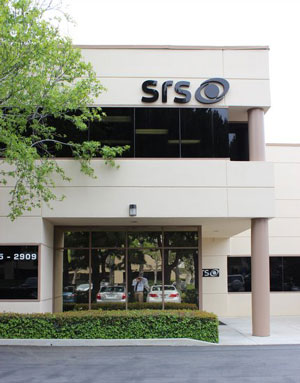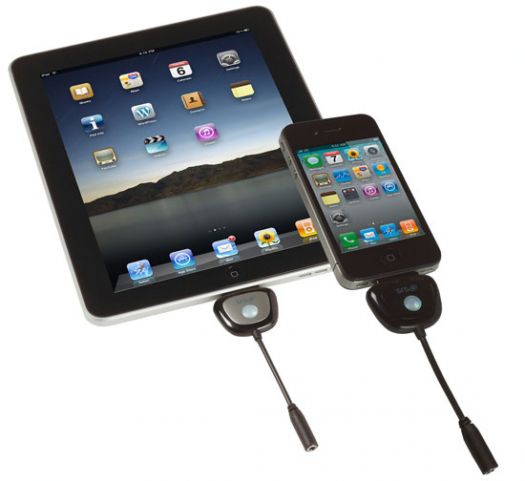Back in January at the Consumer Electronics Show in Las Vegas, I had the opportunity to speak with some folks from SRS Labs regarding their latest innovation, Circle Cinema 3D. However, since CES is the worst venue on Earth to practice the fine arts of focus and critical listening, SRS kindly extended an offer to bring me out to their CA headquarters in the Spring for a closer look at what they've been up to. Just before the Easter holiday, I was able to take them up on that offer and what I saw (and heard) during my visit was enough to make me think that SRS could be looking at a big year ahead.
About SRS
If you're struggling to recall why the SRS name sounds so familiar, you might want to check your TV or soundbar. According to a 2007 DisplaySearch report, 7 of the top 9 flat panel TV manufacturers feature at least one of SRS Labs' audio technologies.
Although they don't always appear on configuration menus using these names, some of the company's more prevalent technologies include TruSurround, TruVolume, Circle Surround, and - coming soon to a flat panel display and/or sound bar near you - the aforementioned Circle Cinema 3D.
Established in 1993, SRS Labs was formed when the company's founding partners purchased the rights and assets of various audio and speaker technologies from the Hughes Aircraft Company. Soon after came the company's IPO in 1996, during which the company raised approximately $22 million.

iWOW 3D
Billed as an "audio enhancement adapter" for iPhone, iPod, and iPad, the iWOW 3D package is comprised of two components. Inside the box you'll find a small dongle which connects to the 30-pin jack on your iPhone, iPod, or iPad. Next you'll need to visit the App Store and download the "SRS iWOW 3D app." Using the app, you'll quickly discover that pre-defined iWOW listening modes include "Speakers," "Car," and "Headphones," the latter being the default and the option you'll likely use most often.
Unfortunately, I didn't have my iPod Touch with me during my visit to the SRS office. However, the SRS folks kindly provided me with a sample which I was able to test out on my long flight back east. Somewhere over Utah, I came to understand why they named it "iWOW."
The "WOW" factor definitely varies depending on the quality of the track you're listening to, but quality cuts featuring a high bit rate exhibited improved spaciousness and a greater number of audible details, particularly with live performance recordings such as a BoDeans album I enjoyed in flight.

TruVolume
After our iWOW discussion, my hosts and I moved over to a corner of SRS' beautifully-designed meeting and demonstration room. Here they had set up a trio of flat panel displays to show off the merits of TruVolume, SRS' volume-leveling technology. I've had the opportunity to experiment with TruVolume on displays I've reviewed in the past, but this side-by-side setup was much more effective in demonstrating the technology's true potential. We've talked about TruVolume before, but good news bears repeating.
The need for something like TruVolume is evident just about every time you watch TV. You're watching a quiet, dramatic scene from a movie and suddenly it cuts to commercial and the latest ad for Bob's Discount Furniture blows you across the room. Kids get woken up, your spouse starts swearing, and "Where the hell is the damned remote?!" Good times all around. (Ironically, here's a cute commercial developed by SRS to simulate the problem.)
As you may know, television broadcasts have an FCC-dictated volume range they're required to stay within. Interestingly, this means that those loud commercials are actually no louder than the loudest portions of what you were watching prior to the commercial break - they only seem louder. They seem louder because they're running at the maximum allowable volume ALL the time, sort of like Seth Rogen. After a few seconds, this assault on your ears can be downright unbearable. Enter TruVolume.
To demonstrate TruVolume, SRS Product Marketing Manager Patrick Serrato played for me the same DVR-recorded satellite content on displays with TruVolume enabled, with TruVolume disabled, and also on a display featuring Dolby's competing product, Dolby Volume. The ESPN clip used was a prime example of the nuisance posed by volume spikes. We also did some channel surfing on the same displays, noting quickly the differences evident as we moved from channel to channel.
On both the single clip test, and the channel surfing test, the Automatic Gain Control (AGC) goodness of TruVolume clearly added a significant improvement to the listening experience, handily taming the rampant spikes evident in the other two setups while maintaining the reference volume level across the board. Bottom line: TruVolume is definitely a feature to look for in your next HDTV.
TruSurround HD
Before moving to the "big room," Patrick and I moved to a different corner of the room we were already in for a quick demo of TruSurround HD, using a race sequence from Cars as our test bed. Handed a remote, I was able to engage or bypass the TruSurround effect on the flat panel display using just one button, making it that much easier to hear the before and after.
The Cars scene we watched, which features Lightning McQueen racing around the track while the announcer narrates the action and the crowd goes wild, is going to sound thin on most 2-speaker displays. It's a big scene in the film: it looks big and it's meant to sound big. With TruSurround off, "big" is not a word that leapt to mind. Turned on however, the size of the racing arena was much better conveyed and the announcer seemed to fill the now-larger space much more effectively. Is it a substitute for a full-blown surround sound speaker system? No. Is it a clear improvement over the stock TV speaker experience? Definitely.

CircleCinema 3D (CC3D)
The biggest news coming out of SRS recently is their new CircleCinema 3D product, a speaker virtualization technology designed for maximum immersion giving the listener a realistic sense of space and improved depth perception. CircleCinema 3D is also the first product of SRS' recently-completed Advanced Rendering Lab, which we'll get to in a minute.
Before heading to the ARL, Patrick wanted to show me what CircleCinema 3D could do in a more practical setting. On the other side of the room, Patrick had a Samsung flat panel display and Samsung soundbar connected to a Blu-ray Disc player spinning everyone's favorite go-to demo title, Avatar. Audio from the Blu-ray player first went through a laptop computer, where he was able to enable/disable the CircleCinema 3D processing before the audio ultimately made its way to the soundbar.
Watching the sequence where Jake takes on a pack of "viperwolves," waving his flaming spear in circles to fend them off, we alternated between CircleSurround 3D on and off. This sequence has a lot going on in the surrounds, as the wild animals pace in circles around Jake before ultimately attacking. Consequently, it's a testament to CircleSurround 3D that it greatly improved upon the soundbar's stock 2-channel experience, adding not only more convincing surround effects but also more intelligible dialogue up front and a more robust low end.
The Advanced Rendering Lab (ARL)
While Patrick was entertaining me with Avatar in the meeting room, Stephen Roney, SRS' Director of Product Marketing was busy preparing the grand finale down the hall. As we went to find him, walking through what can only be described as a wholly unremarkable back room, I half expected to bump into Milton on his way from his office in Storage Area B. (An Office Space reference, for the uninitiated.)
After a short walk, we arrived at a door. Like the back room in which it resides, the door too was entirely unremarkable. But beyond this door... oh my. Completed and put into service back in January, SRS' much-touted Advanced Rendering Lab (ARL) is a state-of-the-art audio research and testing facility. Visually a cross between a contemporary/urban-style Manhattan loft and the bridge of the U.S.S. Enterprise, the ARL is the stuff dreams are made of - for geeks like us anyway.
Sporting more than twenty studio monitor speakers and two powered subwoofers, the ARL is where SRS engineers can quickly and easily test new ideas and improvements to SRS' array of audio technologies. "The lab is truly a 21st century research facility where, with the click of a few buttons connected to a powerful software driven system, we can hear our ideas come to life instantaneously and rapidly refine them on the fly," said CTO Alan Kraemer when the ARL was first announced. "I am confident that the technologies that we're developing in this lab will change the audio industry as we know it."
CircleCinema 3D: Take Two
As mentioned earlier, CircleCinema 3D is the newest SRS product and it seeks to deliver a different kind of audio experience than that of traditional surround sound. Unlike the standard 5.1 and 7.1 surround experience, where you hear discrete speakers making their contribution to the sound field, CircleCinema 3D's primary goal is a heightened sense of immersion and a much greater sensation of depth.
After sinking into one of the ARL's comfy leather theater chairs, Stephen Roney fired up a number of CircleCinema demo sequences, the first of which was the same scene from Avatar I had just watched with Patrick. After listening, Stephen asked that always-tricky question when it comes to sound demos: "How many speakers do you think you just heard?" It being a convincing surround experience, I answered six. The correct answer: two.
Moving on to a 5.1 demo, again using Avatar, we began to toggle between the CircleCinema version of 5.1 and traditional 5.1. Once again, the benefits of Circle Cinema shone through, providing a more immersive experience, calling less attention to individual speakers with the exception of the dialogue, which continued to come through front and center.
The best part of listening to CircleCinema 3D in the ARL is that SRS can quickly and easily upmix the sound all the way to 17.2, if desired. Before doing so, I was thrilled to see one of my favorite test discs come out: Master and Commander starring Russell Crowe. Audiophiles everywhere are well versed in the sonic powerhouse that is Scene 4, and after listening to that wood-splintering canon battle in 17.2, I suddenly find my own basement theater somewhat lacking. Truly incredible.
Coming back to Earth, the more impressive demonstration from a practical standpoint was that same Master and Commander clip using only two channels. Although definitely a step down from the 5.1 and 17.2, the fact that CircleCinema 3D can create such a wide-sounding and enveloping sound stage from only two speakers should be of great interest to sound bar and display shoppers looking to keep the number of speakers to an absolute minimum. And CircleCinema 3D's applications don't end there. From talking to SRS, it seems only a matter of time before we'll begin to see CircleCinema 3D listening modes available on A/V receivers and surround sound processors.
Final Thoughts
Looking back, my visit to SRS was definitely an eye opener. (Ear opener?) SRS technologies such as TruVolume and TruSurround have been around for a few years, and though quite prevalent in the marketplace, they just don't seem to garner the attention they deserve from consumers comparing TVs for purchase. It's only when shoppers get these displays and soundbars home that they realize the limitations of two (often small and underpowered) speakers.
Thankfully, this is precisely where SRS' innovative technologies can step in and make a huge impact on buyer satisfaction and the 2-channel experience. That said, when you factor in SRS' new Advanced Rendering Lab and what they're doing with CircleCinema 3D, it's clear that we've only seen the tip of the iceberg from this company, whose employees are clearly passionate about what they do.
More Information: